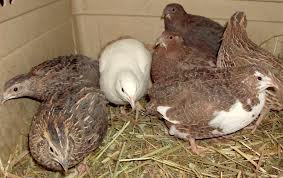Estimation of genetic parameters of egg production and reproductive traits in Japanese quails
Keywords:
Japanese quails;Reproductive traits;Growth traits;Egg production traits;HatchabilityAbstract
The present study wasconducted to estimate genetic parameters of egg production and reproductivetraits in Japanese quail. The response to selection for egg production aftertwo generations of selection was also estimated. A total of five hundred and twentysix Japanese quails, made up of three hundred and ninety seven females and onehundred and twenty seven males were used to conduct the study. Egg number(EGN), Egg weight at 12 weeks of age (EWT12), Age at sexual maturity (ASM) andBody weight at 6 weeks of age (BWT6) averaged 46.04, 8.73gm, 39.73days and163.28gm in generation 1 and the corresponding values for generation 2 are45.36, 9.06gm, 39.86days and 163.70gm. Percent fertility (Fert %) and percenthatchability (Hatch%) were recorded as, 80.43% and 77.99% for the firstgeneration and the corresponding values for the second generation were 82.05% and 67.14%. Heritability estimates of production traitsranged from low to high (0.05 - 0.96). Egg number (EGN) had a negativecorrelation with Age at sexual maturity (ASM) (-1.21) but positively correlatedwith Body weight (BWT) (0.14). Response to selection for egg number was 3.91.Egg number increased, highly significantly (P<0.01) from 36.55 at generationzero to 45.36 at the second generation of selection. In conclusion, selectionin generation 0 based on egg number to 12 weeks of age improved the egg numberand BWT6 in generation 2.
References
Abdel-Mounsef, N.A., 2005. Non-genetic factors affecting some productive traits in Japanese quail. M.Sc.Thesis Faculty of Agriculture Al-Azhar University Cairo. Egypt.
Aboul-Hassan, M.A.,1997. Selection for growth traits in Japanese quail.Early responses. Mansoura J.Agr. Sci., 22, 101-109.
Aboul–Hassan, M.A., 2000. Comparative study of growth traits in two strains of Japanese Quail. Fayoum J. Agr. Res. Dev.,14, 189-197.
Aboul- Hassan M.A., 2001. Crossbreeding effects on some growth and egg production traits among two strains of Japanese quail. Al–Azhar J. Agr. Res., 34, 41-57.
Abdul- Hassan M.A., 2004. Selection for high egg production in Japanese quail : Direct and correlated responses. Al–Azhar J. Agr. Res., 34, 25-40.
Dafwang, I.I., 2006. Nutrient requirements and feeding regiment in Quail production. A paper presented at the National Workshop on Quail Production for Sustainable Household Protein Intake. National Agricultural Extension and Research Liason Services, Ahmadu Bello University, Zaria. September., 11th -13th pp 12-19.
El–Fiky, F.A., 1991. Genetic studies on some economic traits in Japanese quail. Ph.D. Thesis, Faculty Agr. Al-Azhar Univ. Egypt.
El-Fiky, F.A., Shamma, T.A., El-Oksh, H.A., 1994. Genetic parameters of some productive and reproductive traits in Japanese quail. Env. Arid Land Agr. Sci.,5, 45-60.
El–Fiky, F.A., 1995. Effects of intensive inbreeding on some productive traits in Japanese quail. Annal. Agr. Sci. Moshtohor., 34, 189- 202
Food and Agriculture Organization, 1992. Food Agr Organ. Prof. A E. Bender. Meat Production., pp. 2.
Google Earth., 2011. Google location map; Google earth imagery date. December 3rd , 2011.
Haruna, E.S., Musa, U., Lombin, I.H., Tat, D.B., Sharmaki, D.D., Okewole, D.A., Molokwu, J.V., 1997. Int. Quail product. Niger. Niger. Vet. J., 18, 104-107
Henderson, C.R., 1963. Selection index and expected genetic advance. Statistical genetics and plant breeding, National Academy of Science, Nat. Res. Counc. Publ. Wash., Pp 982.
Richtrova, A., 1999. Influence of male presence in cages with female on the parameters of egg production of Japanese quails (Cortinix japonica). Zesyty Naukowe Przegl du Hodowlanego., 45, 189 – 199.
Saatci, M., Omed, H., Ap-Dewi, I., 2006. Genetic parameters from univariate and bivariate analyses of egg and weight traits in Japanese quail. Poul. Sci., 85, 185-190.
Sharaf, M. M., 1992. Genetic and nongenetic estimates of some reproductive and productive traits in Japanese quail. Egypt Poul. Sci.,12, 211-231.
Sittman, K., Abplanalp, H., Fraser, R., 1966. Inbreeding depression in Japanese quail.Genet., 54, 371-379.
Tawefeuk, F.A., 2001. Studies in quails breeding using selection index for the improvement of growth and egg production in Japanese quail. Ph.D. Thesis, Facul. Agr. Tanta. Univ. Egypt.
Wilhelmson, M., 1979. Breeding experiments with Japanese quail.The synthesis of random mated population . Report 39. Swed. Univ. Agr.

Published
How to Cite
Issue
Section
Copyright (c) 2014 E. U. Okuda, M. Orunmoyi, I. A. Adeyinka, E. D. Eze, A. J. Shoyombo, U. Louis

This work is licensed under a Creative Commons Attribution-NonCommercial-NoDerivatives 4.0 International License.



